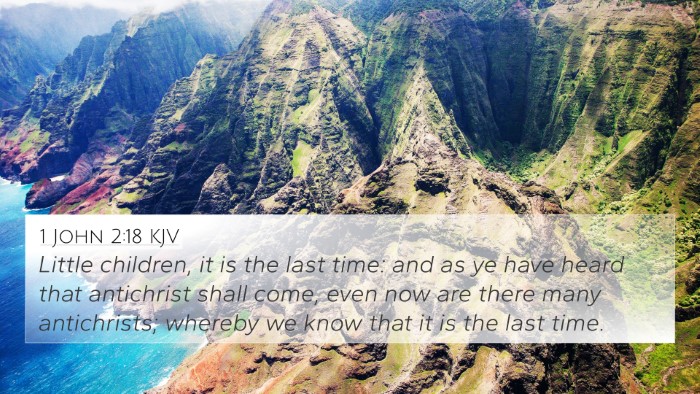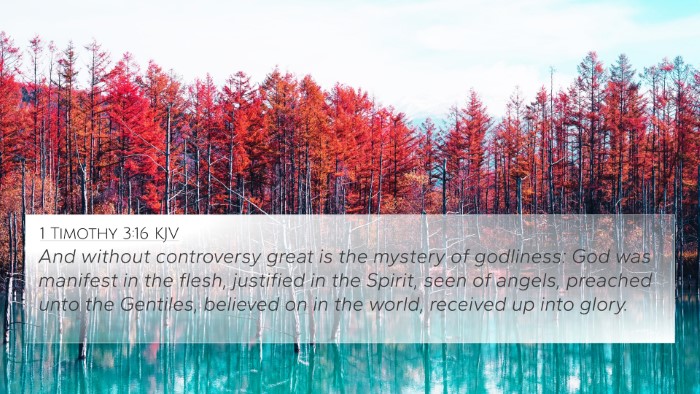Understanding 2 Thessalonians 2:7
Bible Verse: 2 Thessalonians 2:7 - "For the mystery of iniquity doth already work: only he who now letteth will let, until he be taken out of the way."
This verse is rich with theological implications and has captured the attention of many biblical scholars throughout history. Below is a comprehensive analysis combining insights from renowned public domain commentaries to enhance understanding.
Meaning and Interpretation
1. The Mystery of Iniquity
Matthew Henry notes that “the mystery of iniquity” refers to the hidden workings of sin and evil that pervade the world. He suggests that this indicates a continual pattern of rebellion against God's order, which indicates the presence of a powerful deceptive force opposing righteousness.
2. The Restraining Force
Albert Barnes emphasizes that the phrase “he who now letteth will let” denotes a restraining power, which many interpret as the Holy Spirit or a righteous entity that holds back the full revelation of evil in the world. The idea is that God’s presence in the world is currently tempering the manifestation of ultimate lawlessness.
3. The Eschatological Context
Adam Clarke outlines that this scripture points toward an eschatological scenario where there will be a significant shift when the “he” is removed. This is often associated with the end times, suggesting that the full revelation of evil will only occur after this restraint is lifted.
Biblical Connections and Cross-References
This verse connects to several other scripture passages that deepen the understanding of its message. Here are some relevant cross-references:
- 2 Thessalonians 2:3 - Speaks of a falling away and the revelation of the man of sin.
- 1 John 2:18 - Refers to the spirit of antichrist already at work.
- Revelation 13:7 - Discusses the authority given to the beast over the saints.
- Daniel 9:27 - Alludes to a covenant with many and the cessation of sacrifice.
- Matthew 24:12 - Mentions increasing lawlessness leading to the love of many growing cold.
- Romans 1:18 - Explains God’s wrath being revealed against ungodliness.
- John 16:13 - Discusses the future guidance of the Holy Spirit in truth.
- 2 Peter 3:9 - Indicates God's patience in delaying judgment for the sake of repentance.
- Matthew 5:13 - “You are the salt of the earth” implying the preserving role of believers in the world.
- Hebrews 10:25 - Urges believers to gather and not neglect fellowship as the day approaches.
Thematic Connections
This verse exemplifies profound theological themes, which can be seen in the following:
- Human rebellion against God: The ongoing challenge of human nature against divine order.
- The role of the Holy Spirit: His work as a restrainer of iniquity.
- Eschatology: The study of end times and what precedes the final judgment.
- The manifestation of evil: An exploration of how sin develops and takes hold in societal structures.
Cross-Referencing Techniques
Understanding 2 Thessalonians 2:7 can be enhanced through various tools for Bible cross-referencing:
- Bible Concordance: A valuable resource for locating specific verses and understanding themes.
- Bible Cross-Reference Guide: Offers systematic links to related scriptures.
- Cross-Reference Bible Study: Methodologies for comprehensive comparative analysis.
- Bible Reference Resources: Aggregating multiple texts that relate to specific teachings.
Conclusion
In conclusion, understanding 2 Thessalonians 2:7 requires a blend of careful study and analysis across various biblical texts. The verse highlights the interplay between divine restraint of evil and the inevitable unfolding of iniquity as we approach significant prophetic events. Through cross-referencing and thematic study, readers can gain richer insights into the Scriptures as they relate to each other, forming a cohesive understanding of Biblical teachings on sin, restraint, and eschatological fulfillment.










